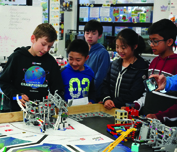A recent study has investigated students’ attitudes and abilities when it comes to creativity, comparing the results of art students with those who study STEM. Although students from different fields had different ideas about what it meant to be creative, there was a strong overlap in the personal skills needed to show creativity.
The study found that openness, creative self-efficacy, and divergent thinking were likely prerequisites to creativity, regardless of the field of study.
Openness refers to a willingness to entertain new ideas and tolerate ambiguity; creative self-efficacy is a student’s belief in their creative abilities; and divergent thinking is the ability to come up with novel ideas and solutions.
Kim van Broekhoven of Maastricht University, Professor David Cropley of UniSA, and Dr Philipp Seegers of the University of Cologne performed the study, which involved a total of 2,277 undergraduate and graduate students aged between 17 and 37 at German universities. One-hundred and thirty participants were enrolled in an Art degree, while 2147 participants were enrolled in STEM.
“This finding then adds weight to the importance of broad educational support for these ‘person’ factors of creativity, from kindergarten to university,” wrote the authors. “Openness and creative self-efficacy support creativity for the artist as much as they do for the scientist.”
Unlike openness, creative self-efficacy and divergent thinking, which were important regardless of discipline, the characteristics of a creative product did show more clear disciplinary differences. Each discipline – art, science, engineering – values different aspects of creativity.
“Both art and science students strongly associated originality (novelty) with creativity,” say the authors. “This strong association was greater among art students compared to science students. Both art and science students moderately associated effectiveness with creativity.”
The researchers hypothesised that art students would focus on originality in their ideas of creativity, whereas STEM students would see feasibility and effectiveness as areas for creative activity. However, very few students from either field associated feasibility with creativity. “
There is little practical difference in the way art and science students perceive product creativity or associate key product qualities with creativity. Both, it can be said, see originality as central to defining the creativity of a product, with effectiveness also moderately important.”
The researchers assumed that since people in STEM fields often make decisions based on practicality and effectiveness, rather than on beauty or originality, they would see such pursuits as creative. The results, however, point to a general idea of creativity shared by students across the disciplines that creativity is foremost a matter of originality.
Creativity is recognised as a 21st century competency that will only become more relevant as industries develop. The researchers urge educational institutions to help foster creative skills, but point out that they must be understood first.
“Without a clear, evidence-based understanding of the nature of creativity across the four elements of creativity, it is hard to formulate strategies for nurturing specific creative competencies through high school and into universities. Any individual, to be creative, benefits from high openness, high creative self-efficacy, and a strong ability to think divergently. Education at all levels must respond accordingly, providing broad support for these elements of creativity.”
Kim van Broekhoven, David Cropley, & Philipp Seegers. (2020). ‘Differences in creativity across art and STEM students: we are more alike than unalike’, Thinking Skills and Creativity. https://doi.org/10.1016/j.tsc.2020.100707
For more information, please contact David Cropley at UniSA -David.Cropley@unisa.edu.au.
MCERA, an independent, not-for-profit organisation, provides a conduit through which education research and researchers are made more accessible to the media to help improve public understanding of key education-related issues. We provide journalists with expert, independent and accessible insights from education researchers and practitioners. Any views expressed by the experts we consult are not necessarily those of
MCERA or its staff.





